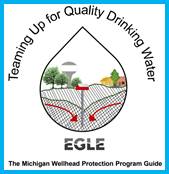About Protect Your Water / Wellhead Protection
Goal
The goal of the management plan is to specify how actual and potential sources of contamination in a wellhead protection area (WHPA) will be managed in order to prevent them from reaching the aquifer. Each community may custom design a plan and select the control measures which are most appropriate for their plan. Management approaches may involve a variety of activities including facility inspections, land-use regulations, operational policies, best management practices, public information and education.
To help communities attain this goal, wellhead protection areas will be considered as special management areas by many supporting organizations. The state, for example, will give special attention to facilities and properties within a wellhead protection area when conducting underground storage tank inspections, granting groundwater discharge permits or inspecting hazardous waste sites. Other agencies such as county health departments and watershed councils may offer similar support once involved in a local wellhead protection program.
WHPA Management Program Objectives
- To have the appropriate land use planning and management mechanisms in place to prevent contamination of the public water supply system
- To generate support and direct appropriate attention, inspections, and regulatory activities to the WHPA for management by local, county, state and federal government agencies
- To identify and minimize or eliminate land use activities which pose significant threats to groundwater
- To identify and utilize available local resources, including volunteer and staff resources, to address needs for wellhead protection area management
- To motivate landowners within the wellhead protection area to take steps to reduce threats to groundwater
- To educate residents, business and industry on the importance of wellhead protection and the need for them to do their part to protect the public water supply system
- Evaluate ways to direct new growth or redevelopment that supports wellhead protection. Sewer and water extensions, roads and other infrastructure should be considered in the planning process
- Require best management practices within the wellhead protection area including secondary containment for hazardous substance storage, proper floor drain connections, construction of grassed swales for onsite storm water management and sealing of abandoned wells
WHPA Management Program Options For Consideration
Intergovernmental Coordination Options:
Communication with adjacent units of government on an ongoing basis is essential for management of the wellhead protection area especially since delineations often cross many jurisdictional boundaries. If the adjacent community has land within the wellhead protection area, establish an ongoing mechanism for communication such as:
- Joint city/township meetings of planning commissioners
- Joint education programs related to methods for ground water protection
- Adoption of similar ground water protection site plan review standards for all jurisdictions
- Information exchange on development plans
Other intergovernmental coordination options to consider include:
- Modify and use the state/county environmental permits checklist for your community. Distribute the checklist to persons considering business operation or land purchase within the wellhead protection area.
- Notify federal, state, county and local regulatory offices about WHPP goals and the location of the WHPA.
- Consider partnership agreements among agencies to formalize the exchange of information and services.
Public Awareness and Education Options:
- Post "wellhead protection area" signs at the edge of the wellhead protection area
- Post drains to drinking water recharge area signs at storm drain openings if drains discharge to the WHPA
- Publicize the program through: local newspaper, community newsletter, municipal and/or public access cable television, posters, library displays, school programs, etc.
- Carry out hazardous material surveys through the Firefighter Right-to-Know program
- Provide technical assistance to agricultural landowners (Farm *A* Syst for ground water protection)
Technical Assistance Regulatory Options:
- Develop community wide zoning provisions for ground water protection (site plan review standards)
- Target inspections by fire chiefs to facilities within the WHPA, which may have hazardous substances on site
- Develop locally-based regulatory and incentives program for site cleanup
- Require, through local zoning ordinance, additional information about hazardous substance and onsite management practices when new development is proposed within the wellhead protection area
Land Protection and Land Use Planning Options:
One of the major recommendations when developing a wellhead protection area management plan is to incorporate the boundaries of the wellhead protection area into the local Master Plan. Incorporation of wellhead protection area boundaries will help community leaders recognize the extent of this area and the need to determine what goals and objectives should be included as part of their Master Plan which will serve to protect their drinking water supply. This will emphasize the importance of wellhead protection and provide consistency in the program as community leaders change.
Other land protection and land use planning options include:
- Purchase of land by government agencies
- Purchase of conservation easements by government agencies
- Obtain donations of development rights by landowners
- Advance purchase of lands for new well fields preferably in locations separate from current well fields
- Transfer of development rights initiatives (new legal options may be proposed through Michigan legislation)


